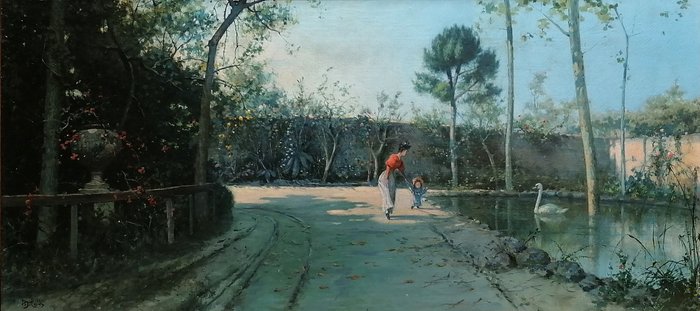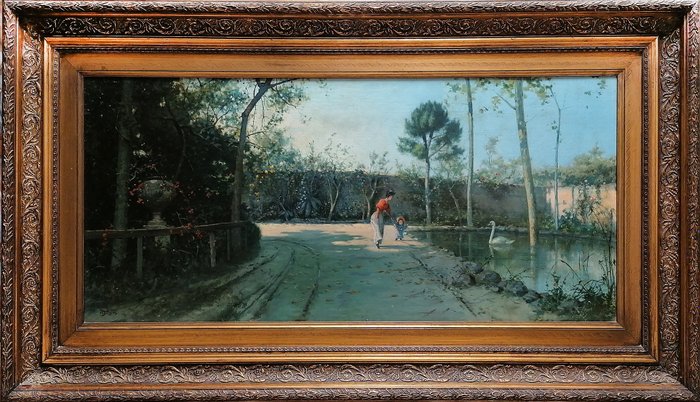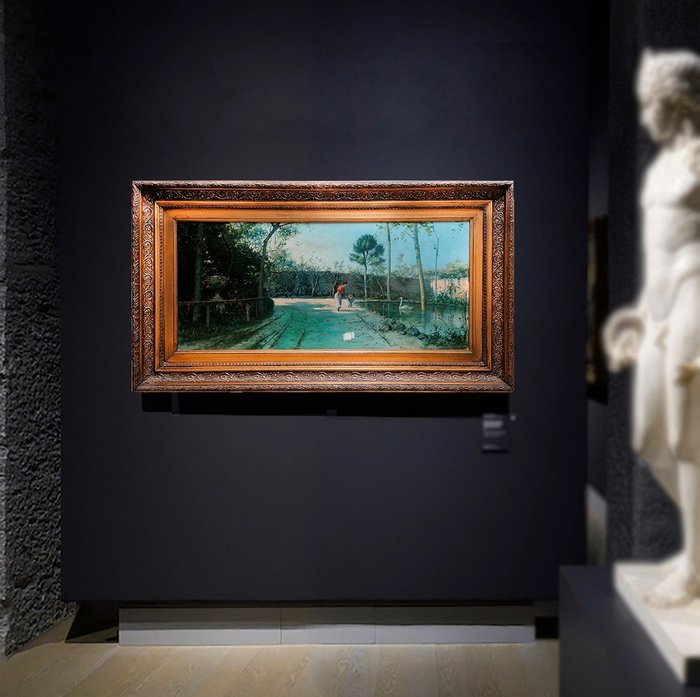Advert Description
Are you interested in this item? This item is up for auction at Catawiki. Please click on "respond to advert" (orange button) to get redirected to the Catawiki website. Catawiki’s goal is to make special objects universally available. Our weekly auctions feature thousands of unusual, rare, and exceptional objects you won’t find in just any store. MICHELE CATTI
(Palermo, 1855 - 1914)
Walk in the gardens
Oil on canvas, cm. 46 x 101.8 – Signed ‘M CATTI’ lower left
Frame size, cm. 74 x 129 x 8 approx.
NOTES: Publication of the catalog of works from the Intermidiart collection. Signed lower left. On the back it bears an old label with origin and signature (?); Work from a Sicilian collection; Certificate of Lawful Origin. Work with coeval gilded and worked frame (?) (defects):
Precious works for artistic value, by the illustrious Italian painter of indisputable talent, Catti Michele (Palermo, April 5, 1855 - July 4, 1914), a figure who, together with Francesco Lojacono and Antonino Leto - known triad of the greatest Sicilian landscape painters of the nineteenth century - contributed to creating in our island that magical happy cultural moment, between the nineteenth and twentieth centuries, which saw G. B. Filippo and Ernesto Basile, Giuseppe Damiani Almeyda, Mario Rutelli, Antonio Ugo, Vincenzo Ragusa, and many other no less significant artists who, starting from academic experiences between neoclassicism and romanticism, have expressed the sense of modernity inherent in impressionism and in modernist language.
In this context of lively local artistic ferments, enlivened by contacts with other much more lively realities in Sicily - think of Naples, Rome, Florence and Paris itself - Michele Catti occupies an anomalous position, due to his feeling imbued with poignant melancholy that comes to become the anguish of living. His painting, from vaguely Macchiaioli ways, crossing Impressionism, touches on the crepuscular post-impressionism; he, the only bohemian artist in Palermo, interprets his city in a unique way, giving us autumnal visions of its modern tree-lined avenues, making it more similar to Nordic capitals than to Mediterranean cities, as in the case of our work.
Michele Catti was born in Palermo on April 5, 1855 to Andrea and Carmela Riotta. To escape the pressures of his parents who, in accordance with family tradition, had decided to start him on legal studies, and to freely pursue his own interests aimed more at painting, he ran away from home when he was still a young man and found hospitality with the writer Luigi Natoli. The latter introduced him to the artistic circles of Palermo, always protecting and honoring him with his friendship. After a brief apprenticeship with the painter Francesco Lo Jacono, not tolerating the monotonous exercise and the meticulous, almost photographic copy of the reality to which he was obliged, he abandoned him to approach nature in a more direct way. Already at his first public appearance, in 1875 in Palermo, where he exhibited Burrasca d'autunno at the Promotrice, he was noticed and admired by J. L. Gérome. The Promoter was still present the following year with Tramonto d'inverno (De Gubernatis). The friendship that bound him to the painter Vincenzo Ragusa dates back to those same years who, as soon as he returned from Japan, did not fail to interest him in the transparencies of oriental painting, under whose suggestion C. executed some decorations in Palermitan patrician houses (Giardina, p . 11). In 1881 he was present with Crepuscolo at the National Exhibition in Milan and in the same year he rehearsed with The landing of Garibaldi in Marsala (Palermo, private owner) in a historical subject [...]. Initially linked to a realistic setting, his interests gradually turned, after 1885, to an impressionism mediated through the painting of Antonio Leto, resolved with an increasingly sparse and broad brushstroke, in which the light flakes the form, flattening the images against an undefined background.
In 1891 he exhibited in Milan and at the Promotrice of Palermo, where he was also present in 1893. In 1892 he painted Castel di Tusa (Palermo, privately owned) and in 1896 he reported personal success at the Exhibition which was held at the Palermo Artistic Circle with the paintings Summer, Spring, Autumn and Winter. Also in Palermo he held a personal exhibition in 1898 and in 1899 he exhibited at the Fine Arts exhibition organized at the Massimo theater. A true type of bohemian, Catti lived secluded and with few friends, afflicted by family troubles and precarious health conditions, moreover in continuous economic difficulties. One of his pupils, a German painter named Krep, was very close to him; together with him he was a frequent visitor to the taverns, where he often paid with a painted picture or mirror.
His more mature works can be dated from the early years of the twentieth century, characterized by a smooth brushstroke and a sure and vibrant drawing with which he reacted to the flaking of the forms of the previous works. In particular, he loved sad autumnal atmospheres, gray skies and cold windy days in which the subtle and refined accords of dull tones veil a simple daily reality devoid of any rhetoric with melancholy. On the initiative of Vincenzo Pastore, he held a large solo exhibition in Palermo in 1910 comprising thirty-five works and, the following year, he was awarded the gold medal at the National Exhibition in Rome for the painting Last leaves of 1909 (Palermo, Civica Galleria d 'modern Art). In the work in question, which can be dated towards his maturity, the collaboration for some features of his son Aurelio Catti is not excluded, above all - on the right - in some points.
The work of excellent artistic and chromatic rendering is in good condition with the signs of aging visible in the photos. At the bottom left it bears a black signature (see photo). On the back it bears an old label with origin and signature (?). The painting, of good pictorial quality, is in a French gilded frame, probably coeval (?). The painting shows traces of dirt caused by time, signs that testify to the years of work.
ORIGIN: Coll. Private Sicily
PUBLICATION:
? Unreleased;
? The Myths and the Territory in Sicily with a thousand cultures. UNEDITED QUADRERIA general catalog of paintings from the collection of the cycle "Myths and the territory", Editore Lab_04, Marsala, 2023.
We also guarantee careful packaging with an external wooden crate and internal bubble wrap/cardboard/polystyrene (packaging cost approximately €100.00) and tracked shipping (€100.00 Italy). For export, the work is subject to a request for a Certificate of Free Circulation (European Community) or a Certificate of Export (Extra Community Transport), at the export office (Superintendency of the territory) with the times and costs burdened ( €350/€900, all included: shipping, packing and some exports).
The shipment could be delayed by a few days/weeks for logistical and administrative reasons. 67406123





